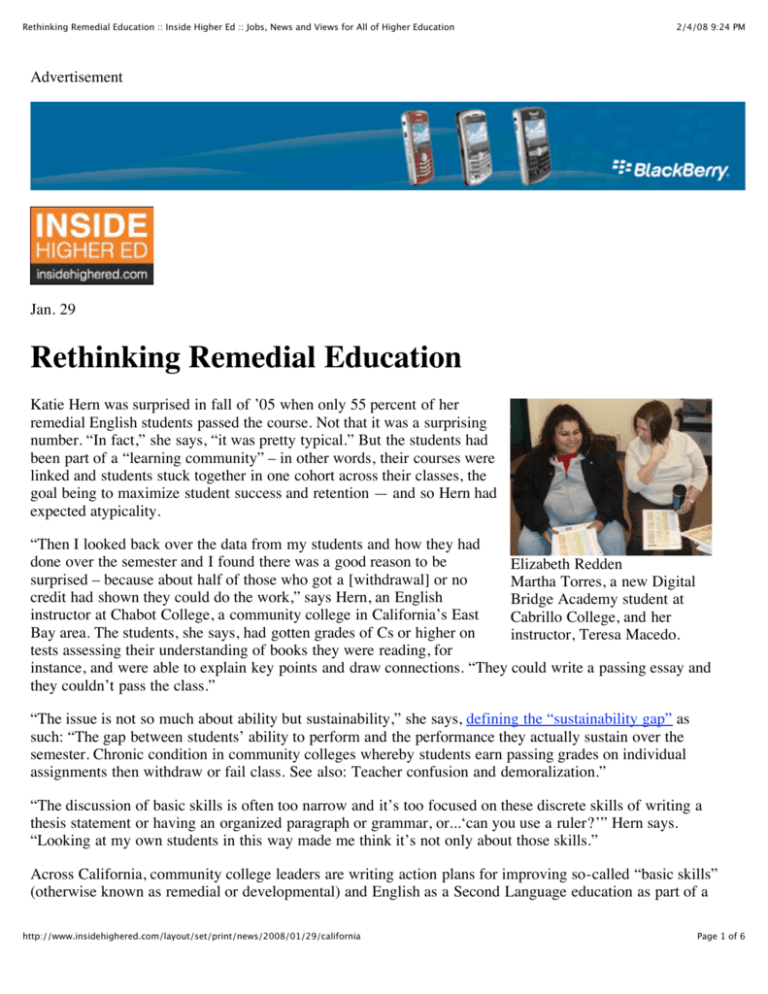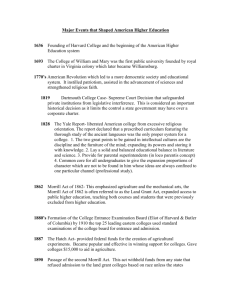Rethinking Remedial Education __ Inside Higher Ed __ Jobs, News
advertisement

Rethinking Remedial Education :: Inside Higher Ed :: Jobs, News and Views for All of Higher Education 2/4/08 9:24 PM Advertisement Jan. 29 Rethinking Remedial Education Katie Hern was surprised in fall of ’05 when only 55 percent of her remedial English students passed the course. Not that it was a surprising number. “In fact,” she says, “it was pretty typical.” But the students had been part of a “learning community” – in other words, their courses were linked and students stuck together in one cohort across their classes, the goal being to maximize student success and retention — and so Hern had expected atypicality. “Then I looked back over the data from my students and how they had done over the semester and I found there was a good reason to be Elizabeth Redden surprised – because about half of those who got a [withdrawal] or no Martha Torres, a new Digital credit had shown they could do the work,” says Hern, an English Bridge Academy student at instructor at Chabot College, a community college in California’s East Cabrillo College, and her Bay area. The students, she says, had gotten grades of Cs or higher on instructor, Teresa Macedo. tests assessing their understanding of books they were reading, for instance, and were able to explain key points and draw connections. “They could write a passing essay and they couldn’t pass the class.” “The issue is not so much about ability but sustainability,” she says, defining the “sustainability gap” as such: “The gap between students’ ability to perform and the performance they actually sustain over the semester. Chronic condition in community colleges whereby students earn passing grades on individual assignments then withdraw or fail class. See also: Teacher confusion and demoralization.” “The discussion of basic skills is often too narrow and it’s too focused on these discrete skills of writing a thesis statement or having an organized paragraph or grammar, or...‘can you use a ruler?’” Hern says. “Looking at my own students in this way made me think it’s not only about those skills.” Across California, community college leaders are writing action plans for improving so-called “basic skills” (otherwise known as remedial or developmental) and English as a Second Language education as part of a http://www.insidehighered.com/layout/set/print/news/2008/01/29/california Page 1 of 6 Rethinking Remedial Education :: Inside Higher Ed :: Jobs, News and Views for All of Higher Education 2/4/08 9:24 PM system-wide initiative. Foundations have poured in funds to improve instruction and the scaffolding that supports it. And in the classrooms, often with foundation support, faculty are talking about developmental education in new ways, re-imagining what it is and how to do it, and experimenting with curricular innovations — with the goal of creating models for other instructors operating in solitude behind their classrooms’ closed doors. “We wanted colleges to create occasions when faculty could step back from their teaching,” says Pat Hutchings, vice president of the Carnegie Foundation for the Advancement of Teaching, which has joined with the William and Flora Hewlett Foundation to grant 11 California community colleges about $300,000 each over the past three years to test out innovations in basic math and English skills education. (The Hewlett Foundation has provided the funds, which the Carnegie Foundation has then “re-granted” to the participating colleges: Cerritos, Chabot, Glendale Community, Laney, Los Medanos, Merced, Pasadena City, and West Hills Colleges, plus the City College of San Francisco, the College of the Desert and College of the Sequoias.) The James Irvine Foundation is also funding innovations at nine colleges (with some overlap), while other bold new programs, like Cabrillo College’s Digital Bridge Academy, have received funding from a host of sources. “There’s so much teaching in the traditional sense of the word – people in their classrooms, preparing materials – but there’s not much time for faculty to step back and think about what they’re doing, how it could be better,” says Hutchings. What Does That Innovation Look Like? One Example: Ed Lopez, 46, is adjusting to his new schedule. After more than three years of being a stay-at-home dad, he started classes at Cabrillo College’s Watsonville, Calif. center last week through the Digital Bridge Academy, a highly-structured, full-time program that bills itself as stressing acceleration, not remediation, for high-risk students. “I’m waking up five minutes earlier every day and still am barely getting here on time,” he said on Thursday, the third day of the program’s introductory “foundation” class. On that drencher of a Central Coast morning, he’d left his binder at home. “I’m probably going to have to start doing the backpack thing.” What is this program that brought Lopez back to college? In 2002, Diego Navarro, a community college and Harvard University Business School graduate with about 20 years of experience in the computer industry, got his first funding to design the Digital Bridge Academy. “I spent the first three months interviewing 325 people all over the country who work with high-risk young adults, trying to figure out what works, what are the problems, what it is that I can actually contribute, what can Cabrillo College contribute,” Navarro says. “What I started to find is that there are holes. There are significant holes.” Hearing stories of student success and failure, “Every time I heard these stories,” he says, “I’d ask, ‘What lit their fire?’ And I’d hear over and over again, ‘I don’t know.’” “So I started to realize that I needed to develop a curriculum that would light a fire in a student. What does that look like?” The Digital Bridge Academy begins with a two-week foundation course designed to do just that. During Thursday’s all-day session, students practiced identifying the learning styles of one another, hypothetical individuals and movie characters. (“If you can perceive the styles of other people, then you can see where they fit in on a team,” Navarro explains. “What we’re doing fundamentally with students is teaching them how to see the styles of other students so they can become leaders.”) http://www.insidehighered.com/layout/set/print/news/2008/01/29/california Page 2 of 6 Rethinking Remedial Education :: Inside Higher Ed :: Jobs, News and Views for All of Higher Education 2/4/08 9:24 PM Earlier in the week, students had completed a series of exercises demonstrating differences in perception. For Martha Torres, a former meth user who’s coming to college at age 30, clean for two years and now part of a Watsonville, Calif. Digital Bridge Academy cohort this spring, the lesson was personal. In the past, she says she thought that “If I was using, people would think of me as a mean, bad person who didn’t care about her life. It wasn’t like that at all.” But nor could she believe her friends when they would say to her face that she was just going through a rough time, that they didn’t perceive her as the mean, bad person that she perceived that they perceived her to be. “Before I had a low self-esteem, real low.” After the foundation course, students in the Digital Bridge Academy, now part of a learning community, continue taking a full semester load of credit-bearing courses together — in career and educational planning, information technology, literacy, movement, and “team self-management.” Those courses all revolve around the program’s core class, in which students conduct a primary research project on a social justice issue. Students learn to use Excel in the information technology course, for instance, in time for them to analyze data for their projects, which in the past have focused on topics like youth gangs and discrimination against new immigrants. (The population of Watsonville, where the program was first launched, was as of the 2000 U.S. Census about 75 percent Latino.) “See, my students have Ph.D.’s in social injustice. They really understand social injustice inside themselves, deeply. They’re very curious and they’re very interested in understanding why,” Navarro says. “That’s why we accelerate because students are studying something they’re very interested in. They’re involved in the knowledge creation process.” Faculty from across the various Digital Bridge Academy courses work together: In fact, two were present during Thursday’s foundation course to help out the teacher of record, Teresa Macedo, a sociologist, and get to know the students. (A third Cabrillo instructor was also observing as part of a practicum to learn to teach the class.) All courses — including the foundation course, which borrows many elements from corporate training programs — count toward the associate degree. After the semester ends, students mainstream into the traditional basic skills and transfer-level courses at Cabrillo, as needed, although they can stay connected to the program through paid internships (where responsibilities include recruiting future academy students). The Digital Bridge Academy program has now been expanded to three other California community colleges – the College of Alameda, and Las Positas and Merritt Colleges – and Navarro hopes to expand it to six total before bringing it to a national scale around 2010. He has plans to incorporate a numeracy component in the curriculum and also design a two-semester program to prepare would-be science students for transferlevel biology, chemistry and physics. And he cites the data to back up his expansion plans. The program, which he says has received more than $3 million in grants to date from the Hewlett Foundation, the Irvine Foundation, the David and Lucile Packard Foundation, the National Science Foundation, and the Walter S. Johnson Foundation, has shown some impressive results. “Overall, the evidence is that DBA students either outperform or significantly match their peers on academic success and enrollment patterns,” Norena Norton Badway, of the Higher Education Evaluation and Research Group, wrote in a draft external evaluation of the program last year. She writes that the retention rate during the Bridge semester, at 74 to 100 percent across the various cohorts, surpasses the general Cabrillo College student success rate in credit courses of 67 percent. Furthermore, she describes a trend in which Digital Bridge Academy students, who mostly enter at pre-collegiate levels, pass credit-bearing English classes that they hadn’t placed into and for which they were “conventionally considered incapable” — spurring her recommendations that colleges should reconsider beliefs that they should “shelter” underprepared students with easier first semesters, and that the state of California should experiment with accelerated remediation http://www.insidehighered.com/layout/set/print/news/2008/01/29/california Page 3 of 6 Rethinking Remedial Education :: Inside Higher Ed :: Jobs, News and Views for All of Higher Education 2/4/08 9:24 PM programs like the Digital Bridge Academy. She also recommends that the academy continue to collect extensive data on student backgrounds to develop a more robust definition of what it means to be “at-risk.” By many conventional metrics, the academy’s students tend to be high-risk. At Watsonville, 91 percent are Latino or other minorities, 70 percent are from ESL backgrounds, 63 percent are from migrant worker families, and 65 percent are first-generation college students. Program coordinators, however, strive for diversity in age and educational background to “balance” risk levels. At 46 and looking to land a job in computers with greater security, Lopez, for instance, already has an associate degree from a technical institute in electrical engineering technology (and about 50 credits at Cabrillo that he’s never been able to translate into a degree in the less structured format more typical of the community college experience). Torres, meanwhile, a mother of three, is in college for the first time. As is Avery Perez, 19, who plans to open five businesses and who says he dresses to challenge expectations and stereotypes. He wore a backwards Chicago Cubs hat Thursday. Asked if he was a Cubs fan, he said no. Other Innovations: The Digital Bridge Academy is just one example – albeit a major one – of the innovation happening at California community colleges around basic skills. In addition to innovations funded through the Carnegie/Hewlett partnership, MDRC, a social policy research organization, has partnered with the Irvine Foundation to “re-grant” $3.725 million in Irvine funds to nine California community colleges (American River, De Anza, Merced, Mt. San Antonio, Pasadena City, Santa Ana, Taft, and Victor Valley Colleges, plus the College of Alameda). The Student Support Partnership Integrating Resources and Education (SSPIRE) grants, worth up to $250,000 over three years and launched in 2006, fund programs making student services available “in a way that resonates and that [students are] able to access and use,” says Evan Weissman, an operations associate for MDRC and the SSPIRE program director. “With the idea that’s going to be most effective if it can be integrated into the classroom — to lessen the divide between the student services that are often already available on campus and what’s going on for the students in the classroom.” For example, several colleges, like De Anza and Santa Ana, have worked at infusing support services into learning communities, Weissman says. Pasadena City College’s Teaching and Learning Center created an intensive, two-week summer “Math Jam” that requires participants to follow up with support services in the fall in order to reap benefits of the program — including free textbooks on loan — says Brock Klein, codirector of the center. “It’s important to note that success in math is an outcome for us, but we’ve been at this for a long time and we know that transforming students’ outcomes and behaviors takes more than two weeks. Our short-term outcomes are about connectedness to college, identification of a support network, the creation of friends — in other words those affective things that make students feel comfortable on campus,” says Klein. Students who complete the intensive, free, “no-credit, no-stress” Math Jam before fall classes start are guaranteed a slot in a math class that fall (meaning they won’t have to worry about classes filling up on them) and receive a textbook on loan. In exchange, they agree that, over the course of the semester, they’ll visit their instructor at least twice during office hours, meet an academic support counselor at least twice, and connect with their tutor from the summer Math Jam at least eight times. The program is open to students who place into various levels of developmental math. Sixty-eight students participated in 2006 when it began; in its second year, participation doubled. http://www.insidehighered.com/layout/set/print/news/2008/01/29/california Page 4 of 6 Rethinking Remedial Education :: Inside Higher Ed :: Jobs, News and Views for All of Higher Education 2/4/08 9:24 PM Meanwhile, in one individual classroom at an institution receiving a Carnegie Strengthening Pre-collegiate Education in Community Colleges (SPECC) grant, an instructor reports strong improvements in performance once she started requiring students to read and outline their textbooks. “I’ve always felt that a problem with math and science is that students don’t learn how to read their books,” says Laura Graff, an associate professor of mathematics at the College of the Desert. At Chabot, also one of the Carnegie-funded colleges, Tom DeWit, an English instructor, stresses the importance of reading — “the common denominator” — as a cornerstone in efforts to incorporate basic skills instruction in courses across the curriculum. The college recently created an hour-long video, “Reading Between the Lives” (a “Tom DeWit Production"), featuring students discussing their thoughts on reading and how it fits into their complex existences. DeWit says there are literally thousands of copies out there across the state. “We really do need to find a way to ask students where they’re at and where they’re struggling, and we need to represent that so that other instructors and other students can hear that and see it.” “The two biggest things we’ve tried to do in the last three or four years are to find a way to take basic skills instruction beyond the hallways of English, ESL and math,” says DeWit. “So that it’s not siloed in those areas alone, and those teachers sort of take care of those students and then they’re ready for college or something.” The statistics vary depending on who’s counting and how, but anywhere between 50 and 70 percent of California’s more than 2.6 million community college students need remedial math or English. Developmental coursework is controversial as a public policy issue, as many question using tax dollars to duplicate educational services students should have received in high school. Regardless, in 2006, California’s 109-college system identified basic skills development as “a major focus” of community colleges in its strategic plan. “The goal is to identify model basic skills and English as a Second Language programs and their key features and, given availability of funds, to facilitate replication across the [c]olleges. In addition, best practices in classrooms and labs and descriptions of effective learning environments will be collected and disseminated widely to inform and assist both credit and noncredit programs. However, noncredit basic skills courses are funded at approximately 60 percent of the rate provided to credit basic skills courses, which is a disincentive for colleges to offer those courses,” the strategic plan’s executive summary states. Each year for the last two, the system has reallocated about $30 million and distributed it across the colleges to be used for basic skills improvements. Foothill College in Los Altos Hills also received two grants from the system to coordinate professional development statewide, says Carole Bogue-Feinour, vice chancellor for academic affairs for the California Community Colleges System. The system commissioned a literature review of effective practices in developmental education and developed a self-assessment tool for colleges “to see what the match is and where there are gaps,” says Bogue-Feinour. She emphasizes a focus on support services as well as innovative curricular design (echoing a conclusion of the literature review that “research has fairly consistently demonstrated that the historical ‘one instructor, one classroom, limited suite of support services’ model to developmental education is not particularly effective.”) As a condition of the basic skills funding, action plans from the colleges on this issue are due in May – also reflecting a finding in the literature review that the improvement of basic skills education must be an institutional priority and responsibility. Meanwhile, at many of the colleges experimenting with new approaches in the classroom, the effort is much more organic, much more grassroots. Common features at the colleges participating in Carnegie’s SPECC http://www.insidehighered.com/layout/set/print/news/2008/01/29/california Page 5 of 6 Rethinking Remedial Education :: Inside Higher Ed :: Jobs, News and Views for All of Higher Education 2/4/08 9:24 PM program, for instance, include learning communities and faculty inquiry groups. At many colleges, a small handful of faculty, 10 to 15 or so, are actively engaged in the questioning process. “What we’re finding is that starting with one small group that is formal and organized and officially linked to the [Carnegie] project has given rise to people saying, ‘Oh, I’d like to do this in my department or with other colleagues who are working on reading or all the faculty who are involved with a learning community,” says Rose Asera, a senior scholar and director of SPECC for Carnegie. “There are a lot of things going on,” adds Hutchings, Carnegie’s vice president. “The [system-wide] Basic Skills Initiative is certainly a huge push ahead. We’ve been actively involved in the conversations around that and particularly around the possibility of some more coordinated attention to all these basic skills education issues and professional development for the people who can lead the charge on these campuses – the very people we’re working with.” “I do see a convergence of forces, and an attempt to take to another level, regional or state, some of the aspects of a number of projects that are underway.” — Elizabeth Redden The original story and user comments can be viewed online at http://insidehighered.com/news/2008/01/29/california. © Copyright 2008 Inside Higher Ed http://www.insidehighered.com/layout/set/print/news/2008/01/29/california Page 6 of 6







